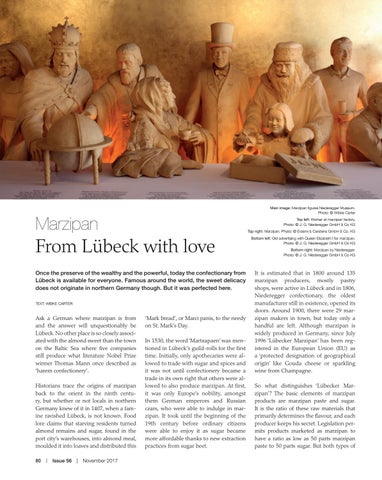Discover Germany | Travel | Feature
Main image: Marzipan figures Niederegger Museum. Photo: © Wibke Carter
Marzipan
Top left: Worker at marzipan factory. Photo: © J. G. Niederegger GmbH & Co KG Top right: Marzipan. Photo: © Erasmi & Carstens GmbH & Co. KG
From Lübeck with love Once the preserve of the wealthy and the powerful, today the confectionary from Lübeck is available for everyone. Famous around the world, the sweet delicacy does not originate in northern Germany though. But it was perfected here. TEXT: WIBKE CARTER
Ask a German where marzipan is from and the answer will unquestionably be Lübeck. No other place is so closely associated with the almond sweet than the town on the Baltic Sea where five companies still produce what literature Nobel Prize winner Thomas Mann once described as ‘harem confectionery’. Historians trace the origins of marzipan back to the orient in the ninth century, but whether or not locals in northern Germany knew of it in 1407, when a famine ravished Lübeck, is not known. Food lore claims that starving residents turned almond remains and sugar, found in the port city’s warehouses, into almond meal, moulded it into loaves and distributed this 80 | Issue 56 | November 2017
‘Mark bread’, or Marci panis, to the needy on St. Mark’s Day. In 1530, the word ‘Martzapaen’ was mentioned in Lübeck’s guild-rolls for the first time. Initially, only apothecaries were allowed to trade with sugar and spices and it was not until confectionery became a trade in its own right that others were allowed to also produce marzipan. At first, it was only Europe’s nobility, amongst them German emperors and Russian czars, who were able to indulge in marzipan. It took until the beginning of the 19th century before ordinary citizens were able to enjoy it as sugar became more affordable thanks to new extraction practices from sugar beet.
Bottom left: Old advertising with Queen Elizabeth I for marzipan. Photo: © J. G. Niederegger GmbH & Co KG Bottom right: Marzipan by Niederegger. Photo: © J. G. Niederegger GmbH & Co KG
It is estimated that in 1800 around 135 marzipan producers, mostly pastry shops, were active in Lübeck and in 1806, Niederegger confectionary, the oldest manufacturer still in existence, opened its doors. Around 1900, there were 29 marzipan makers in town, but today only a handful are left. Although marzipan is widely produced in Germany, since July 1996 ‘Lübecker Marzipan’ has been registered in the European Union (EU) as a ‘protected designation of geographical origin’ like Gouda cheese or sparkling wine from Champagne. So what distinguishes ‘Lübecker Marzipan’? The basic elements of marzipan products are marzipan paste and sugar. It is the ratio of these raw materials that primarily determines the flavour, and each producer keeps his secret. Legislation permits products marketed as marzipan to have a ratio as low as 50 parts marzipan paste to 50 parts sugar. But both types of
